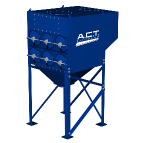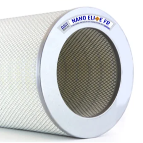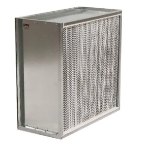
Plant expanding? Replacing an old dust collector? Getting into compliance? Cleaning up your work environment? If you answered "yes" to any of those questions, improving your industrial indoor air quality should be a top priority.
In manufacturing facilities, airborne dust doesn't just settle on equipment - it affects worker health, product quality, equipment performance, and your bottom line. The right industrial dust collector captures contaminants at the source, giving you a proven way to create a cleaner, safer, more efficient operation while meeting regulatory standards.
Why Industrial Indoor Air Quality Matters
If you manage a production floor, you juggle targets for throughput, maintenance, safety, and employee retention. Poor air in the plant undermines every one of those goals.
OSHA notes that inadequate air quality is tied to headaches, fatigue, respiratory irritation, and lost productivity. Dust settling on overhead beams, light fixtures, and control panels can also contaminate finished goods, accelerate equipment wear and attract regulatory scrutiny.
Operations that upgrade air-handling with a high-efficiency dust collector frequently report:
- Cleaner, brighter facilities that are easier to keep audit-ready
- Fewer nuisance trips on downstream equipment thanks to reduced dust infiltration
- Higher morale, lower absenteeism, and better employee retention
- Measurable reductions in unplanned maintenance expenses
Before you invest in a collector, however, it pays to match the system to your specific process, dust properties, and plant constraints.
Consider Your Application
Over time, dust from cutting, grinding, welding, blasting or finishing can blanket rafters and ductwork. Vibration eventually shakes that debris loose, sending contaminants into the breathing zone and threatening product quality.
Cartridge collectors excel at fine, lighter-loading applications such as welding fumes, laser or plasma cutting, and smoke. Their pleated media delivers a large surface area in a compact footprint. Baghouse collectors handle higher dust volumes and coarser particulates typical of woodworking, grain, or mineral processing.
A.C.T. Dust Collectors' lineup includes both styles plus specialty units like the ACTion Booth - a walk-in workstation that captures ambient sanding or blasting dust - and the LaserPack series, designed with integrated spark arrestors for hot-work fumes.
Know Your Dust Properties
Particle size, density, and chemistry dictate filtration strategy. Consider questions such as:
- Are the particles sub-micron welding fume or heavier metal chips?
- Is the material abrasive (e.g., glass bead), corrosive (e.g., battery acid dust), or both?
- Does the process generate moisture or oil mist that could blind filters?
Most importantly, is the dust combustible?
OSHA's Combustible Dust National Emphasis Program lists metals, wood, plastics, grains, chemicals, and paper among the materials that can deflagrate when dispersed. NFPA 652 now requires a documented Dust Hazard Analysis (DHA) for any process handling combustible particulates, with existing facilities expected to have completed a DHA by September 7, 2020, and to review it every five years.
If you're unsure, laboratory dust hazard testing - particle size analysis, bulk-density measurement, and explosibility screening - can guide filter media selection, housing design, and explosion-vent sizing. Reputable suppliers, including those that partner with Conversion Technology, offer dust-testing services as part of the specification phase.
Examples:
- Abrasive dust: cast-iron grit from shot-blasting cabinets
- Corrosive dust: acidic vapor condensate from battery manufacturing
- Combustible dust: powdered sugar or fine wood flour in food and furniture plants
Matching the filter media and collector gauge to these traits protects workers and extends equipment life, which is critical to safeguarding long-term industrial indoor air quality.
Understand Your Manufacturing Environment
Your facility's unique characteristics will influence system selection and placement.
Do you have enough clearance for service access? Facilities with tight ceilings often favor low-profile cartridge dust collectors or place units outdoors to reclaim valuable floor space.
Cold-weather plants must keep hoppers warm to prevent condensation that cakes filters, while facilities in hot, humid regions may need corrosion-resistant housings and drain provisions. New construction projects can route ductwork optimally, but retrofits demand modular collectors that fit through existing doors or outdoor systems that simplify combustible-dust compliance.
Must Read: Should My Dust Collector be Installed Indoors or Outdoors?
Bring in a Dust Collection Specialist
Specifying a system goes beyond CFM calculations. A consultative partner like A.C.T. Dust Collectors can conduct site surveys or review construction drawings to confirm capture points, fan sizing and duct routing. We can model pressure loss to determine proper motor horsepower and filter area, plus provide 3-D renderings so you can visualize maintenance clearances before equipment ships.
Here's a real-world example: An Ohio metal recycling facility needed to contain yellow smoke plumes from torch-cutting large steel chunks outdoors. The challenge? Steel pieces moved by crane couldn't be relocated indoors. A.C.T. engineers partnered with the plant team to create an innovative solution - a mobile building on railroad tracks housing an ACT 4-48 dust collector rated for 24,000 CFM. The building rolls over the work zone to contain smoke, which is then filtered and safely returned to the environment.
Industrial Air Quality and Compliance
Regulatory momentum is shifting from "good practice" to enforceable limits. OSHA may cite employers under the General Duty Clause if airborne dust poses a recognized hazard.
Installing a properly engineered dust collector and documenting maintenance helps your facility avoid fines, reduce workers' compensation claims, and demonstrate due diligence during insurer audits.
Frequently Asked Questions
What is considered poor indoor air quality in industrial settings?
While OSHA has no single standard, sustained particulate concentrations above occupational exposure limits or visible dust accumulations signal poor air quality.
How does an industrial dust collector improve air quality?
It captures contaminated air at the source, filters out particles, and either recirculates clean air or exhausts it safely outdoors, preventing dust from settling or being inhaled.
Are dust collectors required for OSHA or EPA compliance?
They're not mandated by name, but they are an accepted engineering control for meeting OSHA's General Duty Clause and EPA particulate limits, and for satisfying NFPA combustible-dust safeguards.
Can a dust collector help reduce sick building syndrome?
Yes. By minimizing airborne irritants that trigger symptoms, collectors support healthier, more comfortable workspaces and often lead to better employee satisfaction.
Ready to Take control?
Industrial indoor air quality is too important to tackle with guesswork. A purpose-built dust collection system protects your people, your products and your profit margin while keeping regulators satisfied. Now is the time to audit your air quality before issues arise.
Request a quote, get help selecting the right system, or schedule a site visit with A.C.T. Dust Collectors and ensure your next project is done right the first time.



























%20Collectors%20Image.png?width=143&height=143&name=ADC%20(Ambient)%20Collectors%20Image.png)




























.png?width=240&height=91&name=ACT%20Dust%20Collectors%20Logo%20Solid%20White%202020%20(1).png)
.png?width=148&height=149&name=usa-manufactured-dust-collectors%20(1).png)